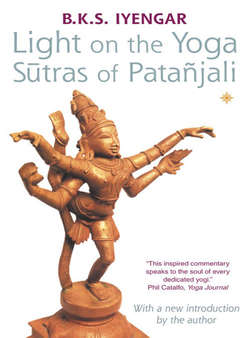Читать книгу Light on the Yoga Sutras of Patanjali - Литагент HarperCollins USD - Страница 28
Cosmology of nature
ОглавлениеIn samkhya philosophy, the process of evolution and the interaction of spirit and matter, essence and form, are carefully explained.
To follow nature’s evolution from its subtlest concept to its grossest or most dense manifestation, we must start with root nature, mula-prakrti. At this phase of its development, nature is infinite, attributeless and undifferentiated. We may call this phase ‘noumenal’ or alinga (without mark): it can be apprehended only by intuition. It is postulated that the qualities of nature, or gunas, exist in mula-prakrti in perfect equilibrium; one third sattva, one third rajas and one third tamas.
Root nature evolves into the phenomenal stage, called linga (with mark). At this point a disturbance or redistribution takes place in the gunas, giving nature its turbulent characteristic, which is to say that one quality will always predominate over the other two (though never to their entire exclusion; for example, the proportion might be 7/10 tamas, 2/10 rajas, 1/10 sattva, or any other disproportionate rate). The first and most subtle stage of the phenomenal universe is mahat, cosmic intelligence. Mahat is the ‘great principle’, embodying a spontaneous motivating force in nature, without subject or object, acting in both creation and dissolution.
Nature further evolves into the stage called avisesa (universal or non-specific) which can be understood by the intellect but not directly perceived by the senses. To this phase belong the subtle characteristics of the five elements, which may be equated with the infra-atomic structure of elements. These may be explained at a basic level as the inherent quality of smell in earth (prthvi), of taste in water (ap), of sight or shape in fire (tej), of touch in air (vayu) and of sound in ether (akasa). The ‘I’ principle is also in this group.
The final stage, visesa, in which nature is specific and obviously manifest, includes the five elements, the five senses of perception (ears, eyes, nose, tongue and skin), the five organs of action (arms, legs, mouth, generative and excretory organs), and lastly the mind, or the eleventh sense. So in all, there are twenty-four principles (tattvas) of nature, and a twenty-fifth: purusa, atman, or soul. Purus permeates and transcends nature, without belonging to it.
(When purusa stirs the other principles into activity, it is the path of evolution. Its withdrawal from nature is the path of involution. If purusa interacts virtuously with the properties of nature, bliss is experienced; for such a purusa, prakrti becomes a heaven. If wrongly experienced, it becomes a hell.
Sometimes, purusa may remain indifferent, yet we know that nature stirs on its own through the mutation of the gunas, but takes a long time to surface. If purusa, gives a helping hand, nature is disciplined to move in the right way, whether on the path of evolution or involution.)
The sixteen principles of the visesa stage, are the five elements, the five senses of perception and five organs of action, and the mind. They are definable and distinguishable. At the avisesa stage, all five tanmatras – smell, taste, sight or shape, touch and sound – and ahamkara, ego, are undistinguishable and indefinable, yet nevertheless entities in themselves. At the material level of creation, tamas is greater than rajas and sattva, whereas at the psycho-sensory level, rajas and sattva together predominate.
The interaction of the gunas with these sixteen principles shapes our destiny according to our actions. Effectively, our experiences in life derive from the gross manifestations of nature, whether painful or pleasurable; that is, whether manifesting as physical affliction or as art. The delusion that this is the only ‘real’ level can lead to bondage, but fortunately the evolutionary or unfolding structure of nature has provided the possibility of involution, which is the return journey to the source. This is achieved by re-absorbing the specific principles into the non-specific, then back into the alinga state, and finally by withdrawing and merging all phenomenal nature back into its noumenal root, the unmanifested mula-prakrti, rather as one might fold up a telescope.
At the moment when the seer confronts his own self, the principles of nature have been drawn up into their own primordial root and remain quietly there without ruffling the serenity of the purusa. It is sufficient to say here that the involutionary process is achieved by the intervention of discriminating intelligence, and by taming and re-balancing the gunas to their noumenal perfect proportions, so that each stage of re-absorption can take place. Yoga shows us how to do this, starting from the most basic manifest level, our own body.
Once the principles have been withdrawn into their root, their potential remains dormant, which is why a person in the state of samadhi is but can not do; the outward form of nature has folded up like a bird’s wings. If the sadhaka does not pursue his sadhana with sufficient zeal, but rests on his laurels, the principles of nature will be re-activated to ill effect. Nature’s turbulence will again obscure the light of the purusa as the sadhaka is again caught up in the wheel of joy and sorrow. But he who has reached the divine union of purusa and prakrti, and then redoubles his efforts, has only kaivalya before him.
